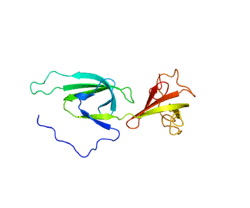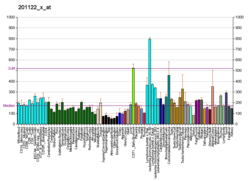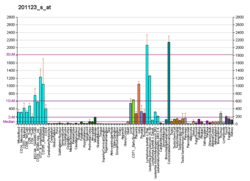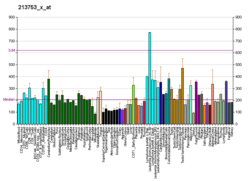EIF5A
Eukaryotic translation initiation factor 5A-1 is a protein that in humans is encoded by the EIF5A gene.[5]
It is the only known protein to contain the unusual amino acid hypusine [N (ε)- (4-amino-2-hydroxybutyl)-lysine], which is synthesized on eIF5A at a specific lysine residue from the polyamine spermidine by two catalytic steps.[6]
EF-P is the prokaryotic homolog of eIF5A, which is also modified post-translationally in a similar but distinct way.[7][8] Both proteins are believed to catalyze peptide bond formation and help resolve ribosomal stalls, making them elongation factors.[9]
References
- ENSG00000288145 GRCh38: Ensembl release 89: ENSG00000132507, ENSG00000288145 - Ensembl, May 2017
- GRCm38: Ensembl release 89: ENSMUSG00000078812 - Ensembl, May 2017
- "Human PubMed Reference:". National Center for Biotechnology Information, U.S. National Library of Medicine.
- "Mouse PubMed Reference:". National Center for Biotechnology Information, U.S. National Library of Medicine.
- Steinkasserer A, Jones T, Sheer D, Koettnitz K, Hauber J, Bevec D (Jun 1995). "The eukaryotic cofactor for the human immunodeficiency virus type 1 (HIV-1) rev protein, eIF-5A, maps to chromosome 17p12-p13: three eIF-5A pseudogenes map to 10q23.3, 17q25, and 19q13.2". Genomics. 25 (3): 749–52. doi:10.1016/0888-7543(95)80025-H. PMID 7759117.
- Wolff EC, Kang KR, Kim YS, Park MH (May 2007). "Posttranslational synthesis of hypusine: evolutionary progression and specificity of the hypusine modification". Amino Acids. 33 (2): 341–350. doi:10.1007/s00726-007-0525-0. PMC 2572820. PMID 17476569.
- Park JH, Johansson HE, Aoki H, Huang BX, Kim HY, Ganoza MC, Park MH (Nov 2011). "Post-translational modification by β-lysylation is required for activity of Escherichia coli elongation factor P (EF-P)". Journal of Biological Chemistry. 287 (4): 2579–2590. doi:10.1074/jbc.M111.309633. PMC 3268417. PMID 22128152.
- Peil L, Starosta AL, Virumäe K, Atkinson GC, Tenson T, Remme J, Wilson DN (2012). "Lys34 of translation elongation factor EF-P is hydroxylated by YfcM". Nature Chemical Biology. 8 (8): 695–7. doi:10.1038/nchembio.1001. PMID 22706199.
- Rossi, D; Kuroshu, R; Zanelli, CF; Valentini, SR (2013). "eIF5A and EF-P: two unique translation factors are now traveling the same road". Wiley Interdisciplinary Reviews. RNA. 5 (2): 209–22. doi:10.1002/wrna.1211. PMID 24402910.
Further reading
- Bevec D, Hauber J (1997). "Eukaryotic initiation factor 5A activity and HIV-1 Rev function". Biol. Signals. 6 (3): 124–33. doi:10.1159/000109118. PMID 9285095.
- Li L, Li HS, Pauza CD, et al. (2006). "Roles of HIV-1 auxiliary proteins in viral pathogenesis and host-pathogen interactions". Cell Res. 15 (11–12): 923–34. doi:10.1038/sj.cr.7290370. PMID 16354571.
- Rasmussen HH, van Damme J, Puype M, et al. (1993). "Microsequences of 145 proteins recorded in the two-dimensional gel protein database of normal human epidermal keratinocytes". Electrophoresis. 13 (12): 960–9. doi:10.1002/elps.11501301199. PMID 1286667.
- Chung SI, Park MH, Folk JE, Lewis MS (1991). "Eukaryotic initiation factor 5A: the molecular form of the hypusine-containing protein from human erythrocytes". Biochim. Biophys. Acta. 1076 (3): 448–51. doi:10.1016/0167-4838(91)90490-q. PMID 1900436.
- Smit-McBride Z, Dever TE, Hershey JW, Merrick WC (1989). "Sequence determination and cDNA cloning of eukaryotic initiation factor 4D, the hypusine-containing protein". J. Biol. Chem. 264 (3): 1578–83. PMID 2492279.
- Park MH, Liu TY, Neece SH, Swiggard WJ (1986). "Eukaryotic initiation factor 4D. Purification from human red blood cells and the sequence of amino acids around its single hypusine residue". J. Biol. Chem. 261 (31): 14515–9. PMID 3095320.
- Koettnitz K, Kappel B, Baumruker T, et al. (1994). "The genomic structure encoding human initiation factor eIF-5A". Gene. 144 (2): 249–52. doi:10.1016/0378-1119(94)90385-9. PMID 7545941.
- Klier H, Csonga R, Joäo HC, et al. (1995). "Isolation and structural characterization of different isoforms of the hypusine-containing protein eIF-5A from HeLa cells". Biochemistry. 34 (45): 14693–702. doi:10.1021/bi00045a010. PMID 7578077.
- Koettnitz K, Wöhl T, Kappel B, et al. (1995). "Identification of a new member of the human eIF-5A gene family". Gene. 159 (2): 283–4. doi:10.1016/0378-1119(95)00136-T. PMID 7622067.
- Joe YA, Park MH (1994). "Structural features of the eIF-5A precursor required for posttranslational synthesis of deoxyhypusine". J. Biol. Chem. 269 (41): 25916–21. PMID 7929297.
- Bevec D, Klier H, Holter W, et al. (1994). "Induced gene expression of the hypusine-containing protein eukaryotic initiation factor 5A in activated human T lymphocytes". Proc. Natl. Acad. Sci. U.S.A. 91 (23): 10829–33. Bibcode:1994PNAS...9110829B. doi:10.1073/pnas.91.23.10829. PMC 45119. PMID 7971969.
- Maruyama K, Sugano S (1994). "Oligo-capping: a simple method to replace the cap structure of eukaryotic mRNAs with oligoribonucleotides". Gene. 138 (1–2): 171–4. doi:10.1016/0378-1119(94)90802-8. PMID 8125298.
- Ruhl M, Himmelspach M, Bahr GM, et al. (1994). "Eukaryotic initiation factor 5A is a cellular target of the human immunodeficiency virus type 1 Rev activation domain mediating trans-activation". J. Cell Biol. 123 (6 Pt 1): 1309–20. doi:10.1083/jcb.123.6.1309. PMC 2290910. PMID 8253832.
- Liu YP, Nemeroff M, Yan YP, Chen KY (1997). "Interaction of eukaryotic initiation factor 5A with the human immunodeficiency virus type 1 Rev response element RNA and U6 snRNA requires deoxyhypusine or hypusine modification". Biol. Signals. 6 (3): 166–74. doi:10.1159/000109123. PMID 9285100.
- Suzuki Y, Yoshitomo-Nakagawa K, Maruyama K, et al. (1997). "Construction and characterization of a full length-enriched and a 5'-end-enriched cDNA library". Gene. 200 (1–2): 149–56. doi:10.1016/S0378-1119(97)00411-3. PMID 9373149.
- Singh US, Li Q, Cerione R (1998). "Identification of the eukaryotic initiation factor 5A as a retinoic acid-stimulated cellular binding partner for tissue transglutaminase II". J. Biol. Chem. 273 (4): 1946–50. doi:10.1074/jbc.273.4.1946. PMID 9442029.
- Schatz O, Oft M, Dascher C, et al. (1998). "Interaction of the HIV-1 rev cofactor eukaryotic initiation factor 5A with ribosomal protein L5". Proc. Natl. Acad. Sci. U.S.A. 95 (4): 1607–12. Bibcode:1998PNAS...95.1607S. doi:10.1073/pnas.95.4.1607. PMC 19115. PMID 9465063.
- Lee YB, Joe YA, Wolff EC, et al. (1999). "Complex formation between deoxyhypusine synthase and its protein substrate, the eukaryotic translation initiation factor 5A (eIF5A) precursor". Biochem. J. 340 (1): 273–81. doi:10.1042/0264-6021:3400273. PMC 1220246. PMID 10229683.
This article is issued from Wikipedia. The text is licensed under Creative Commons - Attribution - Sharealike. Additional terms may apply for the media files.







